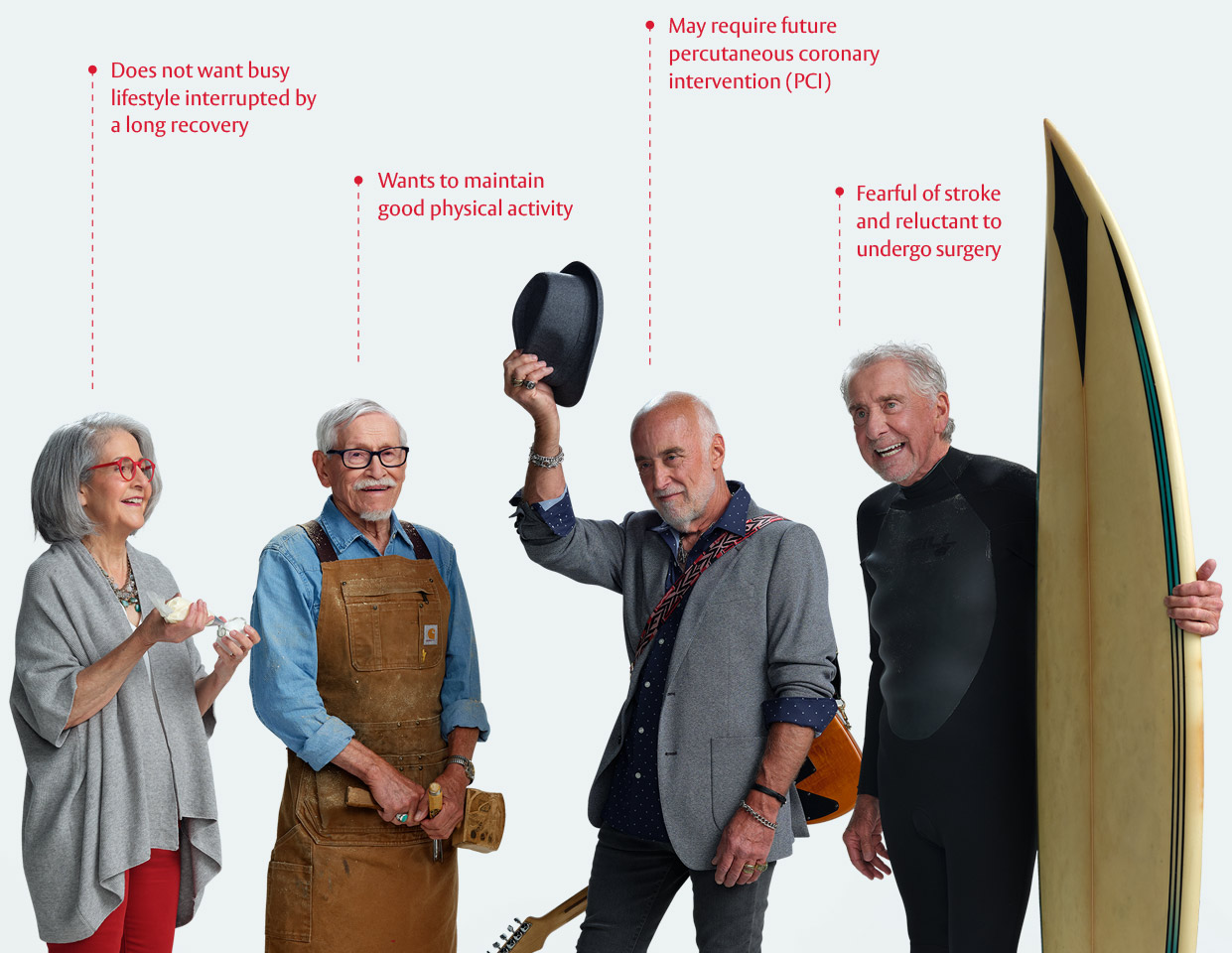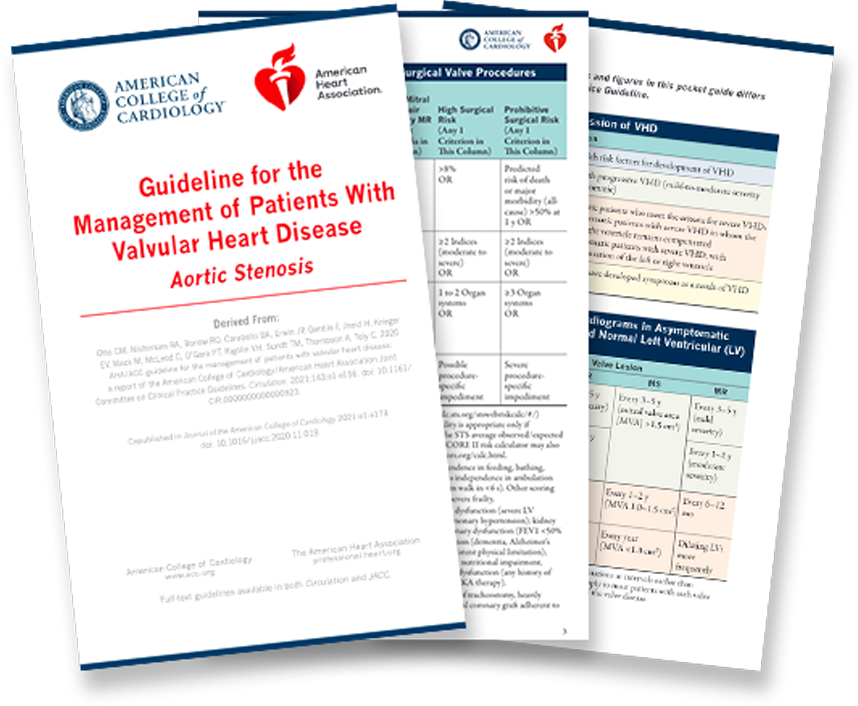The Low-Risk Patient
The Low-Risk Patient
The Low-Risk Patient
The Low-Risk Patient
Unprecedented outcomes for low-risk symptomatic severe aortic stenosis (sSAS) patients with TAVR
Now your low-risk patients have a chance for superior* outcomes with Edwards SAPIEN 3 TAVR. In the past, TAVR was recommended only for high- and intermediate-risk patients, who account for only 2 out of 10 patients. Thus, about 80% of patients received open-heart surgery. But now, you no longer have to reserve the less-invasive option for your sickest patients.
Get the Low-Risk Outcomes Guide*In the PARTNER 3 trial, SAPIEN 3 TAVR was superior to surgery for the primary endpoint (all-cause death, all stroke, and rehospitalization) and multiple pre-specified secondary endpoints.1,3
You have the power to give your patients the best chance at the best outcome by guiding them to a TAVR evaluation
Low-risk sSAS patients are a unique population, with fewer comorbidities (COPD, CAD, and pacemaker) and a mean age 10 years younger than those studied in previous PARTNER trials.1-3


Do you know what the 2020 ACC/AHA Guideline says about TAVR for low-risk sSAS patients?
Edwards Lifesciences has developed a quick assessment to help you further your understanding of the 2020 ACC/AHA Guideline and support your low-risk patients' treatment pathway.
1. According to the 2020 ACC/AHA guideline what is the hemodynamic definition of severe aortic stenosis (Stage C - asymptomatic aortic stenosis)?
Aortic Jet Velocity > 4 m/s or Mean Gradient ≥ 40 HG and Aortic Valve Area ≤ 1.0 cm2
Aortic Jet Velocity < 4 m/s or Mean Gradient ≥ 40 HG and Aortic Valve Area ≥ 0.8 cm2
Aortic Jet Velocity > 4 m/s or Mean Gradient ≤ 35 HG and Aortic Valve Area ≥ 1.0 cm2
Aortic Jet Velocity < 4 m/s or Mean Gradient ≥ 35 HG and Aortic Valve Area ≥ 0.6 cm2
2. According to the 2020 ACC/AHA guideline what is the hemodynamic definition of Stage D2 - symptomatic severe low-flow, low-gradient aortic stenosis (AS) with reduced LVEF?
Aortic Valve Area ≤ 0.7 cm2 and Aortic Jet Velocity < 2.5 m/s or Mean Gradient ≥ 40 mm HG
Aortic Valve Area ≤ 1.0 cm2 and Aortic Jet Velocity < 4 m/s or Mean Gradient ≥ 40 mm HG
Aortic Valve Area ≤ 1.0 cm2 and Aortic Jet Velocity < 4 m/s or Mean Gradient < 40 mm HG
Aortic Valve Area ≤ 0.8 cm2 and Aortic Jet Velocity < 4 m/s or Mean Gradient ≥ 40 mm HG
3. What age range is TAVR recommended in preference to SAVR for Stage D aortic stenosis?
Above 75 years old
Above 80 years old
Above 82 years old
Above 85 years old

4. Which age range should patients with symptomatic severe aortic stenosis (Stage D1) be considered for either TAVR or SAVR?
Between 75-80 years old
Between 60-85 years old
Between 70-80 years old
Between 65-80 years old

5. Which age range should patients with symptomatic severe aortic stenosis (Stage D1) be recommended for SAVR?
Under 70
Under 65
Under 75
Under 60

6. What are the three factors that favor TAVR to SAVR for aortic valve replacement in the ACC/AHA guideline?
Shorter length of stay, mobility issues of patient, previous cardiac operations with at-risk coronary graft
Severe primary mitral regurgitation, mobility issues of patient, longer durability
Severe CAD, mobility issues of patient, previous chest irradiation
Aortic dilation, severe calcification of the ascending aorta, severe renal disease
7. What diagnostic test can assist in diagnosing low-flow, low-gradient symptomatic severe aortic stenosis?
Stress Test
TTE Imaging
CT Imaging
Dobutamine Stress Test
8. According to the 2020 ACC/AHA guideline when should asymptomatic severe aortic stenosis (Stage C1) be followed-up on with Echocardiography?
1-3 months
6-12 months
12-18 months
12-24 months

The face of TAVR is changing
With proven superiority to surgery* SAPIEN 3 Ultra TAVR can help all of your sSAS patients, independent of surgical risk.
View patient profilesA broader view of the TAVR candidate
The following patient profiles can help you better understand the patient types indicated for TAVR.
 Susan, age 73
Susan, age 73Low surgical risk
TAVR Patient
AS disease progression:
Severe AS, symptoms include decreased exercise tolerance
NYHA class: II
Frailty indicators:
0
Surgical risk score: 2
Comorbidities:
None
QoL expectations:
Retired nurse who enjoys frequent travel, working out, and bike rides. She looks forward to an extended life expectancy due to her age and active lifestyle.
 David, age 81
David, age 81Intermediate surgical risk
TAVR Patient
AS disease progression:
Severe AS, symptoms include fatigue, dyspnea upon exertion
NYHA class: III
Frailty indicators:
Passed 3 out of 4 with exception of grip test
Surgical risk score: 6
Comorbidities:
Diabetes, high blood pressure, previous PCI. No other comorbidities.
QoL expectations:
Semi-retired executive for an insurance company. Enjoys walking trails around his home and playing with his grandkids.
 Patricia, age 88
Patricia, age 88High surgical risk
TAVR Patient
AS disease progression:
Severe AS, symptoms include reduced mobility and inability to walk short distances
NYHA class: III
Frailty indicators:
Failed 4/4
Surgical risk score: 10
QoL expectations:
Retired teacher, and requires assistance in daily life activities.
These are a portrayal of typical TAVR patients and not real patients.
Encourage your low-risk sSAS patients to play an active role in their treatment decisions
Help your patients make the best use of their time with you. This guide and symptom tracker can help patients describe the severity of their aortic stenosis, consider treatment needs, and discuss their expectations and concerns.
Download and share the discussion guide
References: 1. Mack MJ, Leon MB, Thourani VH, et al. Transcatheter aortic-valve replacement with a balloon-expandable valve in low-risk patients. N Engl J Med. 2019;380(18):1695-1705. 2. Leon MB, Smith CR, Mack MJ, et al. Transcatheter or surgical aortic-valve replacement in intermediate-risk patients. N Engl J Med. 2016;374(17):1609-1620. 3. Leon MB, Smith CR, Mack MJ, et al. Transcatheter aortic-valve implantation for aortic stenosis in patients who cannot undergo surgery. N Engl J Med. 2010;363(17):1597-1607.